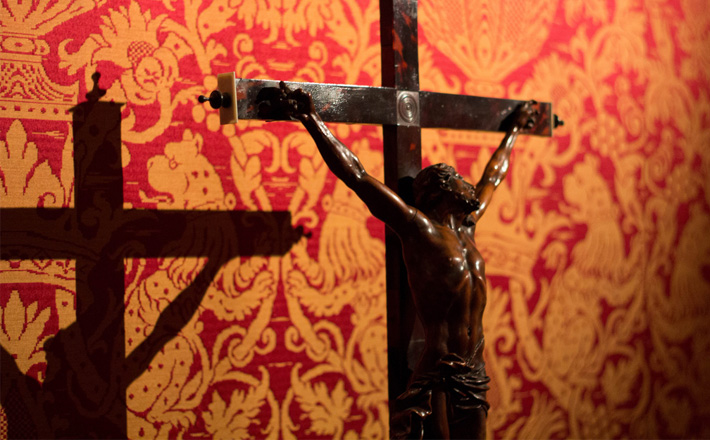Commentary on John 18:1—19:42
Thorny questions rise up when we are confronted with the story of Jesus’ crucifixion.
These are the matters the preacher has to wrestle with for the Good Friday sermon, and it is time for truth-telling. It is not a time for trivializing any — even tiny — aspect of the faith we have been given in Christ Jesus. Pilate himself asks for the truth in John’s Gospel! Along with Pilate, the assembly is ripe for honesty on this day. Here are only some of the possible questions posed by scholars and people of faith for this day’s readings:
Why, really, does Jesus let this torment happen to him? The answer goes a long way toward describing Atonement Theory — and there are several.
Which powerful group is more responsible for Jesus’ death: the religious leaders or the political overlords? Weighing one or the other as having greater force changes the meaning of the death.
Why does the crowd clamor for Jesus’ execution? Is it akin to totalitarian nations today in which emaciated people sing to their dear leader?
What forces stop Pilate from renouncing his ability to stop the execution of someone he says is innocent? Where are the same forces at work today denying justice?
Is Jesus guilty of committing sin by letting people kill an innocent person?
If Jesus is without sin, how can he be fully human? And if he is fully human, what does it mean for him to say that his kingdom is not of this world?
Good Friday is exactly the time to ponder some of the hardest problems of the Christian proclamation and leave the assembly with a thread to pull on, a nugget to explore. It is not easy to approach these matters. Some pastors may want to believe that the Passion story “says it all” on this day, seeing no need to preach.
The story, however, does not answer the questions it raises. For that reason alone, there must be a sermon on Good Friday. People who come for worship at this powerful time do not come in order to be whisked out the door at the end with a skip in their steps. They come to honor and focus on what is of utmost importance to them: issues of life and death, guilt and forgiveness, awe and astonishment at the complexity of the figure Jesus and the richness of the biblical witness.
In the presence of such huge issues, the preacher’s task is to tell us who Jesus is and what he has done for us. Some possibilities:
Jesus is a mirror on which we see the face of all that creates pain in our world. He is a victim who cannot be ignored. On him we see the suffering of all the lives that have been cut short or twisted or denied.
Jesus is an open door through which we are invited to a feast that is a time, first, to contemplate failure, loss, and sorrow, and secondly, to pray for the world and meditate on the cross. We bow before the instrument of his death because through its work, we see our own selves more fully.
Jesus is a king who turns Pilate’s questions around and places them onto his interrogator.
Jesus is the nearly silent one who, faced with accusations that are impossible to address because the accusers have no idea what they are saying, doesn’t even start. Jesus shows us the futility of speaking the truth to those who have no desire to hear. Their personal agendas leave them without the vision needed to listen. This happens all the time in our world.
Jesus is one who loves his mother and his friends. He looks upon them from the agony of his dying and honors them.
In John’s Gospel, Jesus refers to himself with the words of ego eimi — I am — placing himself in the same identity as the voice who spoke to Moses from the burning bush. It is our proclamation that the I am is one. We do not know whether Jesus himself knew himself to be one with God or whether that is the proclamation of the writer of John. Pilate’s inscription over Jesus (“The King of the Jews”), does not say that Jesus said he is the King.
Even at the very end, the Gospel tells us that Jesus maintained the power to determine his response to his life. He “gave up his spirit”; the crucifixion did not take it away from him. John maintains Jesus’ divine power in this way.
The disciples were not in attendance except for “the women,” Jesus’ mother Mary, and the beloved disciple. But Joseph of Arimathea came with Nicodemus and a great and honorific abundance of myrrh and aloe. Although Jesus did not prove to be the one who would rescue the poverty-stricken, hungry, and ill people from the oppression of the Roman government as some had hoped, others could see beyond his death to something enduring. Perhaps they realized their own gratitude. Nicodemus had been given the water of life by Jesus. Joseph was welcomed despite his fear. We stand in their place on this day: welcomed and baptized, invited to the water and the word.
The last words of the Gospel reading are, “they laid Jesus there.” It is the new tomb. This is the right ending place because it is in the tomb where Jesus awaits his Resurrection; it is beside the tomb where the assembly will sit for the Vigil of Easter on Saturday, the ending of the Three Days liturgy. The preacher on Good Friday prepares the assembly for the waiting time by offering an image of Jesus in all the beauty of a death so sacrificial that it makes us weep in horror and gratitude all at once.
[For consideration of what the sermon can be at the Vigil of Easter, check out my article, “Preaching the Easter Vigil: Notes on an ancient sermon.”]


April 18, 2014